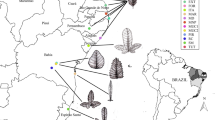Abstract
Difficulties in delimiting well-defined entities in the dogroses (Rosa sect.Caninae) has resulted in very variable taxonomic treatments. The present study was undertaken to provide a background for taxonomy as well as plant breeding. Morphometric diversity was analysed on seedlings obtained from field collections in South Sweden of three species,Rosa dumalis, R. rubiginosa andR. villosa. A canonical variates analysis showed that the three species are relatively distinct whereas two subspecies ofR. dumalis were less well discriminated. Analyses of variance demonstrated that intraspecific variation is pronounced inR. dumalis and, to a lesser extent, inR. villosa.
Similar content being viewed by others
References
Almquist, S., 1919: SverigesRosae. — Stockholm: Idun.
Blackburn, K., Heslop-Harrison, J. W., 1921: The status of the British rose forms as determined by their cytological behaviour. — Ann. Bot.35: 159–188.
Blackhurst, H. T., 1948: Cytogenetic studies onRosa rubiginosa and its hybrids. — Proc. Amer. Soc. Hort. Sci.52: 510–516.
Cole, P., Melton, B., 1986: Self- and cross-compatibility relationships among genotypes and between ploidy levels of the rose. — J. Amer. Soc. Hort. Sci.111: 122–125.
Fagerlind, F., 1940: Sind diecanina-Rosen agamospermische Bastarde? — Svensk Bot. Tidskr.34: 334–354.
—, 1942: Kommt Agamospermie bei dencanina-Rosen vor? — Hereditas28: 224–227.
Gustafsson, Å., 1944: The constitution of theRosa canina complex. — Hereditas30: 405–428.
—, 1942: Meiosis in someRosa-hybrids. — Bot. Not.95: 331–343.
Hurst, C. C., 1925: Chromosomes and characters inRosa and their significance in the origin of species. — Exp. Genet.38: 534–550.
—, 1931: Embryo-sac formation in diploid and polyploid species ofRosaceae. — Proc. Roy. Soc., London, Ser. B, Biol. Sci.109: 126–148.
Jicinska, D., 1976a: Autogamy in various species of the genusRosa. — Preslia48: 225–229.
—, 1976b: Morphological features of F1 generation inRosa hybrids, 1. Hybrids of some species of the sect.Caninae withRosa rugosa. — Folia Geobot. Phytotax.11: 301–311.
Kroon, G. H., Zeilinga, A. E., 1974: Apomixis and heterogamy in rose rootstocks (Rosa canina L.). — Euphytica23: 345–352.
Malmgren, U., 1986: SläktetRosa i Sverige. — Svensk Bot. Tidskr.80: 209–227.
Melville, R., 1975:Rosa L. — InStace, C. A., (Ed.): Hybridization and the flora of the British Isles, pp. 212–227. — London: Academic Press.
Nilsson, Ö., 1967: Drawings of Scandinavian plants 1–8.,Rosa L. — Bot. Not.120: 1–8, 137–143, 249–254, 393–408.
Norusis, M. J., 1990a: — SPSS© advanced statisticsTM user's guide. — Chicago: SPSS Inc.
—, 1990b: — SPSS© base system user's guide. — Chicago: SPSS Inc.
Nybom, H., Olsson, Å., Werlemark, G., 1996: Morphometric variation in Nordic dogroses (Rosa sect.Caninae, Rosaceae). — Acta Univ. Ups., Symb. Bot. Ups.31(3): 59–68.
Ratsek, J.-C., Flory, W. S. Jr.,Yarnell, S. H., 1941: Crossing relations of some diploid and polyploid species of roses. — J. Amer. Soc. Hort. Sci.38: 637–654.
Täckholm, G., 1922: Zytologische Studien über die GattungRosa. — Acta Horti Berg.7: 97–381.
Uggla, M., 1992: Development of rose hip cultivars and growing techniques for establishment of plantations. — In: Balsgård-Department of Horticultural Plant Breeding, Biennial Report 1990–1991, pp. 65–68. — Krístíanstad: SLU.
Weising, K., Nybom, H., Wolff, K., Meyer, W., 1994: DNA fingerprinting in plants and fungi. — Boca Raton: CRC Publishers.
Werlemark, G., Carlson-Nilsson, U., Uggla, M., Nybom, H., 1995: Effects of temperature treatments on seedling emergence in dogroses,Rosa Sect.Caninae L. — Acta Agric. Scand., Sect. B, Soil Pl. Sci.45: 278–282.
Zielinski, J., 1985: Studia and radzajemRosa L. — Systematyka sekcjiCaninae DC. em.Christ. — Arbor. Körnickie30: 3–109.
Author information
Authors and Affiliations
Rights and permissions
About this article
Cite this article
Nybom, H., Carlson-Nilsson, U., Werlemark, G. et al. Different levels of morphometric variation in three heterogamous dogrose species (Rosa sect.Caninae, Rosaceae). Pl Syst Evol 204, 207–224 (1997). https://doi.org/10.1007/BF00989206
Received:
Revised:
Accepted:
Issue Date:
DOI: https://doi.org/10.1007/BF00989206




